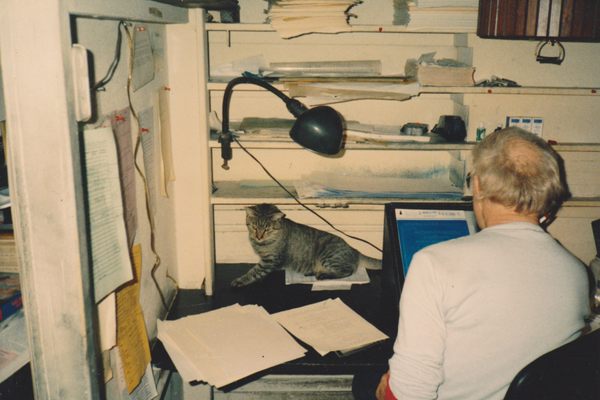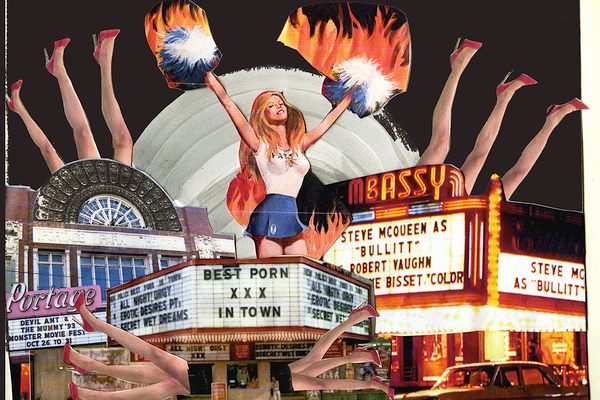Did a Silent Film About a Train Really Cause Audiences to Stampede?
A closer look at an enduring tale of movie-induced panic.

If you’re at all interested in the history of cinema, you’ve probably heard some version of the story about the train film that sent an audience running. According to the tale, as the silent black-and-white image of a moving locomotive filled a movie screen in Paris, the people in the cinema thought it was going to drive right into them. They panicked, and bolted for the back of the theater.
While this story is often taken as fact, it turns out that this theatrical panic is likely no more than a sturdy urban legend—and probably already was even when the film was still in the theater.
The myth of the runaway movie train surrounds a short 1896 film called L’Arrivée d’un train en gare de La Ciotat, or Arrival of a Train at La Ciotat. The 50-second-long silent film was created by Auguste and Louis Lumière, a pioneering set of brothers who were among the very first people to create moving pictures.

Many of the brothers’ early works were barely classifiable as movies even at the time, mostly being short snippets of a scene. “This film is memorable among all the other 1,400 one-minute films (they were called ‘views’ at that time, like ‘living’ picture post cards—single-shot films without any editing), which are listed in the Lumière film catalogue,” says Martin Loiperdinger, a film scholar at the University of Trier, Germany. Loiperdinger is the author of maybe the preeminent piece of writing regarding the myth of La Ciotat, calling the film and its attendant popularity, “Cinema’s Founding Myth.” In the piece he points out that there is no hard evidence that the famed audience stampede ever occurred.
The film itself is a scene on a train platform. Riders mill about the station, while a black steam train pulls in toward the camera, which has been set up close to the edge of the tracks. But even as it was presented as just snapshot of natural action at a train station, the scene was staged by the Lumière Brothers, with the extras being told not to look at the camera.
The movie is often credited as the first documentary film, but this is also untrue. “This film clearly shows a perfect mies-en-scène of a train entering the station, from the perspective of somebody waiting on the platform, standing close to the tracks—thus the locomotive enters the frame from right rear and runs to the left bottom corner of the frame and leaves the frame while the trains stops: a perfect diagonal composition,” says Loiperdinger. The film was beautiful in its simplicity and ability to bring viewers right up and into the action on-screen, even if the scene was a portrait of daily tedium.
It’s almost hard to imagine a black-and-white short creating much of a splash, but it seems like it was a hit. According to Loiperdinger there are no accounts of how the audience reacted at the time, but journalists who wrote about their experiences at the showings of the Cinématographe Lumière, the program of short films in which La Ciotat first began appearing in 1896, seemed reasonably amazed. Even without color or sound, the film’s clear portrayal of three-dimensional movement was a sensation.
Since there are no surviving contemporary accounts of the audience reaction to those 1896 showings, there is no concrete proof that audiences ever went scurrying for the back of theater as the train pulled in on screen, and Loiperdinger thinks that such a reaction is unlikely.
“There is no evidence at all about any crowd panic in Paris or elsewhere during screenings of L’Arrivée d’un train à La Ciotat – neither police reports nor newspaper reporting,” he says. The screen the film was shown on was small (around seven feet wide), and the picture quality was not only lacking color, but it was full of grain. The image flickered noticeably, and of course, there was no sound. In other words, there was no way anyone was confusing the film for reality.
So if it never happened, where did the story of the panicked audience come from?
“The anecdote of train films and panicking audiences was already in the air before 1900,” says Loiperdinger. According to Loiperdinger, tales of panicked audiences began to surface mainly as a way for people to try to describe the emotional power inherent in the then-new medium of film. Writers reporting on Cinématographe Lumière would talk about the train nearly crashing into the audience, but just as a rhetorical method of invoking the convincing 3D effect of the moving picture.
There was also a component of class commentary in the story that spoke to film’s power and effect on the unwashed masses. The erudite, newspaper-reading, educated elites of the day took solace in the idea of rubes getting spooked by a moving image that they would never let affect them in such a way. This can be seen clearly in the 1901 silent film, The Countryman and the Cinematograph, which shows a bumpkin reacting outrageously to a series of short films. There is even a bit where he runs from the image of an oncoming train.
For the same reasons the urban legend of the train and the audience panic first arose around the release of L’Arrivée d’un train en gare de La Ciotat, it continues to survive today. The story still makes for a great shorthand for the power of film, and the elitists still like to giggle at the effect popcorn movies have on the masses. “The anecdote about naïve early film audiences who confuse moving pictures with reality means balm for the souls of self-conscious media consumers in later decades up to today,” says Loiperdinger.
The story of the audience panic and the train film might be bogus, but with advances in 3D making movies come alive like never before, maybe it won’t be long before people finally bring this myth to life.










Follow us on Twitter to get the latest on the world's hidden wonders.
Like us on Facebook to get the latest on the world's hidden wonders.
Follow us on Twitter Like us on Facebook